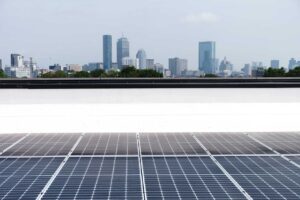Roxbury affordable housing development goes fully electric — even when the power goes out

Down the street from Nubian Square, in a little room on the outside of a new affordable housing building, two enormous cabinets hum away.
These boxes — each about as large an industrial-sized refrigerator — mark a first for the city and state and make the Kenzi at Bartlett Station, a 50-unit development for older adults, the first building taller than four stories in the city that is all-electric — even when the power goes out.
In mid-rise and high-rise buildings — those taller than four floors — building codes require backup energy systems in case of an emergency or power outage. The traditional solution to that requirement is a diesel generator, which makes it challenging for buildings of that height to be 100% electric.
But instead, at the Kenzi — which opened in June and has filled about half of its units, all one- and two-bedrooms for adults over 55 at varying income levels — developers took a different approach to the backup power needs.
In addition to electric heat pumps to heat and cool rooms and a design intended to prioritize energy efficiency, a rooftop solar array hooked up to a battery energy storage system — those two cabinets in the little room off the first floor — is set to provide the power for the emergency systems instead.
In developing the building, which is owned by Preservation of Affordable Housing and was designed by the DREAM Collaborative, staff had to work with the city to determine how the system would work in the space and what protocols would need to be followed.
“There’s no code that dictates this in the state of Massachusetts,” said Julie Klump, vice president of design and building performance at Preservation of Affordable Housing.
The process for getting the system approved included about nine months of meetings with the Boston Fire Department and the city’s Inspectional Services Department to iron out the details.
Similar use of the technology is limited, if it exists at all in the United States. Klump said the Kenzi marks the first use of a battery energy storage system in the city and the state.
Other states like California, which has been using more battery storage systems, might be working on using the technology in larger buildings, but when Klump and Sara Kudra, the affordable housing developer for the DREAM Collaborative, went to a conference in that state and described what they were doing, others there didn’t seem to think anyone else had tried it.
How it works
The system works by collecting energy from the solar arrays on the top of the building. Those panels also generate power for regular use in the building. That input can vary based on how cloudy the day is, but Klump said it can generally account for about half the building’s energy load, and the remainder is purchased from the grid.
The energy generated by the solar array is stored in the batteries. Together, the two cabinets can store 440 kilowatt-hours of energy — compare that to the 500 kwh that the average residential customer in the state uses in a month — and can be used to power systems like the elevators, some lighting and fire alarms.
The Kenzi’s system is also designed to supply power to the community room during outages.
“If the power goes out, residents can come to the community room to refrigerate medication and charge their phones and be in communication with the site staff as they need during an outage,” Klump said.
Residents’ rooms in the building won’t get power from the battery during an outage, but because the building is designed with Passive House certifications — a set of building guidelines with a focus on energy efficiency and better thermal regulation to reduce energy needs — the spaces can maintain heating and cooling for days.
While the diesel generators that are normally used are widely trusted and are the norm in this kind of construction, they can come with their own downsides.
“Diesel exhaust can be hazardous at higher levels,” said Maria Chavez, an energy analyst with the Union of Concerned Scientists, who wasn’t affiliated with the project. “Also, it’s a fuel that you need to access, and you can run out of fuel at any time, especially during extended outages. With solar plus [energy] storage, you have those resources on site.”
An innovative model
Chavez said she found the use of a battery energy storage system at the Kenzi exciting for the opportunities it presents, especially as the technology represents an important step forward for clean energy transitions as the state aims to reach net zero emissions by 2050.

The Boston skyline rises above solar panels on the roof of the Kenzi, an all-electric affordable housing development in Roxbury. BANNER PHOTO
“I feel like it could be a model for future projects and deployments,” she said. “We really need progressive policy that can potentially replicate this model for other and multifamily housing.”
Creating the energy storage system required in the building took some shopping around to find an appropriate battery, said Andy Toomajian, the business development manager at Revision Energy, which handled the renewable energy contracting for the building.
Much of the industry is currently targeted toward smaller off-grid projects or using batteries for convenience, but he said he thinks the market is shifting.
“It was somewhat of a niche product. It took a couple of different vendors to come to a solution that could work,” he said. “But even over the couple years that this project has been in development, we’ve seen more and more people kind of changing that path.”
There’s support for the effort at the state level. The Massachusetts Clean Energy Center, a quasi-public agency focused on growing the clean energy sector, provided a $250,000 grant to Preservation of Affordable Housing to upgrade from a diesel generator to the battery system as a case study for how the technology could work in this application.
In a clean energy transition, the technology has additional uses. Beyond just storing energy for emergency situations, battery energy storage systems can also serve as a useful backup for renewable energy resources that can generate lots of energy, but only when the sun is out or the wind is blowing.
“Let’s say we’re using renewable energy — we can store that energy when the sun is shining and then, when the sun is not shining, we discharge the battery to be able to use the energy later,” Chavez said.
And these systems, like at the Kenzi, can feed back into the grid to offset increased energy use during times of peak demand, for example, when everyone comes home at the end of the day and turns on lights, or during a heat wave when more people turn on air conditioning units.
“Storage, when we have some excess stored energy, subdues that peak so that we don’t have these really exaggerated spikes in demand. It keeps the grid more balanced, therefore keeping our communities safer when they’re trying to keep themselves cool or warm or power the things in their homes that they really need,” Chavez said.
Proof of concept
Toomajian said the project marks an important step as the renewable energy industry works to find solutions to meet code requirements. And its use in a five-story building serves as proof of concept that the same technology could be used in taller structures — the backup power required in a larger building isn’t much higher, he said.
“In a larger building, the emergency loads aren’t necessarily a ton larger,” he said. “If you have six floors of elevators or seven floors of elevators, the energy that elevator needs doesn’t increase so dramatically. Even if you have a lot more residents, if you’re not backing up the residential [energy] loads, the emergency loads are fairly stable.”







